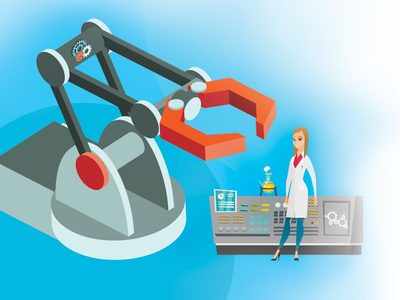- News
- Education News
- News
- How to retain women in STEM researches
Trending
This story is from August 13, 2018
How to retain women in STEM researches
Implicit bias, family pressures and gender stereotype are preventing women from pursuing STEM careers beyond the postdoctoral level, writes Rajlakshmi Ghosh

Despite the greater opportunities in STEM and a rich history of scientists such as Rukhmabai (India’s first practicing doctor), Janaki Ammal (botanist), Ashima Chatterjee (India’s first woman doctorate in Science), Kamala Sohonie (biochemist), Rajeshwari Chatterji (first woman engineer from Karnataka and IISc’s first woman faculty) Shakuntala Devi (mathematical wizard), to mention a few, it has been observed far fewer girls choose to enter the research sector of Science, Technology, Engineering and Math (STEM).
To improve the abysmally less percentage of women in IITs, the MHRD directed 23 IITs to add at least 14% female students in the list in 2018. “The increase in female enrolments happened not been by accident but by design. Our faculty took a proactive approach, mentoring and counselling parents. We had to dispel many pre-conceived doubts,” says V Ramgopal Rao, director, IIT Delhi. The proactive approach helped at IIT Delhi which registered 16% enrolments (143) in the 2018-19 session as opposed to 93 enrolments last year.
Timothy A Gonsalves, director, IIT Mandi, heading the JAB subcommittee set up to increase female enrolment in IITs, says, “We had set a target of 20% seats for girls within the IITs and the results have been encouraging. At IIT Mandi itself, 18% seats (36) have been filled by girls out of 200 seats, which shows their numbers is on the rise.”
Postdoctoral position
Godbole, who has authored Lilavati’s Daughters, a collection of biographical essays on women scientists in India, feels the steady decrease in the numbers is due to their inability to balance a family and career. “Pressure to manage the family needs to change,” Godbole says. The institute now has started a crèche, owing to the high rate of female scientists dropping out owing to family responsibility.
Godbole observed that while there are no dearth of women teaching Science and Mathematics in schools and colleges, the percentage of women faculty of institutes like TIFR (Tata Institute of Fundamental Research), the IITs, or IISc is just 10-12%. “Low percentage of women between the doctoral and professional stages may be attributed to social pressure on women,” she adds.
Need of the hour
Stereotype threat (linked to the common perception that girls are not good in Math) and implicit bias are the reasons why women remain underrepresented in STEM fields, says VK Garg, president and CEO of MPower Global STEM Education, a Gurugram-based firm working on STEM education. Deep-rooted gender discrimination is yet another reason that women are not seen at senior level and sometimes not considered for promotions, adds Garg.
Efforts and initiatives
Government as well as the private sector has introduced a number of programmes to help women resume their careers in science after a break while gender equity in Science and Technology (S&T) as a policy was introduced a decade back. “While that is necessary it is far from sufficient. Flexible postdoctoral positions where women can 1)either work from home (if their research permits) or 2) they can return to a postdoctoral position and rebuild their resume to apply for a job in case they take maternity leave can check attrition rates,” says Godbole.
Timely intervention, at school level, can help mitigate gender imbalance in STEM, feels Mudrika Khandelwal, professor, IIT Hyderabad, who has been closely associated with her institute’s Vignan Jyothi Knowledge Centre to look into coaching, mentorship with role models to stimulate equity and equality in girls’ participation in higher education and STEM careers. “This year, a 2 week residential pilot programme was organised for 30 meritorious class XI girls (from government schools of Kandi and Sangareddy) to expose them to lectures, seminars, lab visits, hands-on sessions, personality development, etc,” says Khandelwal.
Ways to nurture more women in STEM
• Encourage more girls to participate in programmes like Science Olympiads
• Science academies should mentor and showcase work done by women scientists, to an audience of both genders
• Childcare facilities should be made available on campus
• Reward excellence among women
• Provide improved work climate to ensure gender sensitivity and effective addressing of harassment issues
Women versus men in research
As per the UIS (UNESCO Institute for Statistics) data, less than 30% of the world’s researchers are women. The Indian scenario, is far from encouraging with only 14% of Indian researchers being women since Science is seen as a male-dominated bastion. Only 25% of women hold top positions in various institutions and universities with the number being high only in biological research institutes. Women constitute only 14% of 2.8 lakh scientists, technologists and engineers in R&D institutions that translates into approximately 39,389 women while the numbers are 28.4% globally.
To improve the abysmally less percentage of women in IITs, the MHRD directed 23 IITs to add at least 14% female students in the list in 2018. “The increase in female enrolments happened not been by accident but by design. Our faculty took a proactive approach, mentoring and counselling parents. We had to dispel many pre-conceived doubts,” says V Ramgopal Rao, director, IIT Delhi. The proactive approach helped at IIT Delhi which registered 16% enrolments (143) in the 2018-19 session as opposed to 93 enrolments last year.
Timothy A Gonsalves, director, IIT Mandi, heading the JAB subcommittee set up to increase female enrolment in IITs, says, “We had set a target of 20% seats for girls within the IITs and the results have been encouraging. At IIT Mandi itself, 18% seats (36) have been filled by girls out of 200 seats, which shows their numbers is on the rise.”
Postdoctoral position
Keeping in view the larger picture, Indian women constitute almost 40% undergraduates in Science, with Engineering coming a close second. “Even among the PhDs in Science, about 25-30% are women, the actual attrition begins after the PhD. The numbers of women with successful STEM careers is small. In fact, women heading laboratories, science section in government offices in the governing or advisory bodies is not too common,” says Rohini M Godbole, professor at the Centre for High Energy Physics, Indian Institute of Science (IISC).
Godbole, who has authored Lilavati’s Daughters, a collection of biographical essays on women scientists in India, feels the steady decrease in the numbers is due to their inability to balance a family and career. “Pressure to manage the family needs to change,” Godbole says. The institute now has started a crèche, owing to the high rate of female scientists dropping out owing to family responsibility.
Godbole observed that while there are no dearth of women teaching Science and Mathematics in schools and colleges, the percentage of women faculty of institutes like TIFR (Tata Institute of Fundamental Research), the IITs, or IISc is just 10-12%. “Low percentage of women between the doctoral and professional stages may be attributed to social pressure on women,” she adds.
Need of the hour
Stereotype threat (linked to the common perception that girls are not good in Math) and implicit bias are the reasons why women remain underrepresented in STEM fields, says VK Garg, president and CEO of MPower Global STEM Education, a Gurugram-based firm working on STEM education. Deep-rooted gender discrimination is yet another reason that women are not seen at senior level and sometimes not considered for promotions, adds Garg.
Efforts and initiatives
Government as well as the private sector has introduced a number of programmes to help women resume their careers in science after a break while gender equity in Science and Technology (S&T) as a policy was introduced a decade back. “While that is necessary it is far from sufficient. Flexible postdoctoral positions where women can 1)either work from home (if their research permits) or 2) they can return to a postdoctoral position and rebuild their resume to apply for a job in case they take maternity leave can check attrition rates,” says Godbole.
Timely intervention, at school level, can help mitigate gender imbalance in STEM, feels Mudrika Khandelwal, professor, IIT Hyderabad, who has been closely associated with her institute’s Vignan Jyothi Knowledge Centre to look into coaching, mentorship with role models to stimulate equity and equality in girls’ participation in higher education and STEM careers. “This year, a 2 week residential pilot programme was organised for 30 meritorious class XI girls (from government schools of Kandi and Sangareddy) to expose them to lectures, seminars, lab visits, hands-on sessions, personality development, etc,” says Khandelwal.
Ways to nurture more women in STEM
• Encourage more girls to participate in programmes like Science Olympiads
• Science academies should mentor and showcase work done by women scientists, to an audience of both genders
• Childcare facilities should be made available on campus
• Reward excellence among women
• Provide improved work climate to ensure gender sensitivity and effective addressing of harassment issues
Women versus men in research
As per the UIS (UNESCO Institute for Statistics) data, less than 30% of the world’s researchers are women. The Indian scenario, is far from encouraging with only 14% of Indian researchers being women since Science is seen as a male-dominated bastion. Only 25% of women hold top positions in various institutions and universities with the number being high only in biological research institutes. Women constitute only 14% of 2.8 lakh scientists, technologists and engineers in R&D institutions that translates into approximately 39,389 women while the numbers are 28.4% globally.
End of Article
FOLLOW US ON SOCIAL MEDIA










